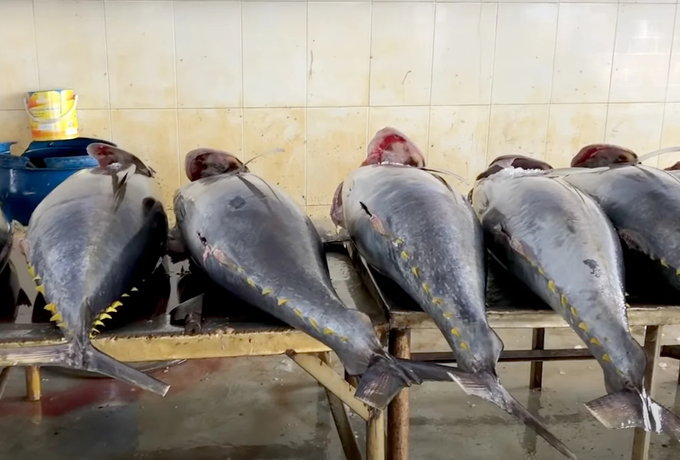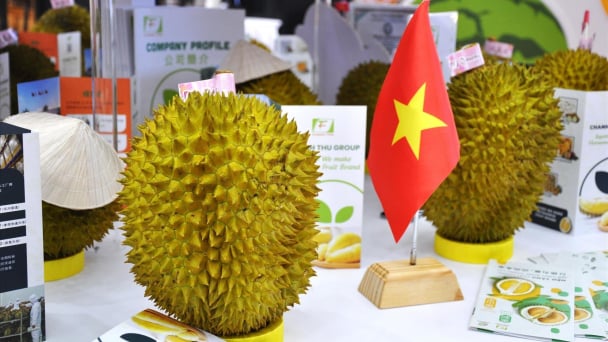June 3, 2025 | 01:25 GMT +7
June 3, 2025 | 01:25 GMT +7
Hotline: 0913.378.918
June 3, 2025 | 01:25 GMT +7
Hotline: 0913.378.918

A fisherman brings tuna to shore. Photo: Son Trang.
In 2023, in the context of the decline in seafood exports, tuna exports also decreased significantly, with a decrease of 17%, reaching US$ 845 million. Thus, after only 1 year of becoming a billion-dollar commodity for the first time (reaching US$ 1.02 billion in 2022), Vietnamese tuna has lost this position.
However, since the last months of last year, tuna exports have begun to recover. Thanks to that recovery, in January this year, tuna exports reached more than US$ 79 million, an increase of 58% over the same period in 2023. Compared to January of 2018 onwards, tuna export turnover in January this year was about 46% higher than the annual average. Mrs. Nguyen Ha, tuna market expert of the Vietnam Association of Seafood Exporters and Producers (VASEP), said that this is a positive signal for tuna in the opening month of the new year 2024.
In February, Vietnam's tuna exports did not maintain the same growth momentum as in January, when they decreased by 11% compared to February 2023, reaching nearly US$ 52 million. However, this decrease was due to the Lunar New Year holiday in February. Although it decreased in February, in the first 2 months of the year, the total tuna exports reached more than US$ 131 million, up 21% over the same period last year.
Tuna exports have grown well in recent months since businesses are actively expanding export markets. According to VASEP, in the first 2 months of the year, tuna products were exported to more than 80 markets, while in the first 2 months of last year there were 70 markets. Thanks to market expansion, businesses have reduced the risk of reduced exports to major markets.
However, looking at the overall market and tuna industry in 2024, tuna export businesses will face many difficulties and major challenges that can slow down the ability to recover production and exports.
The 3 largest markets for Vietnamese tuna are the US, EU and Israel. In 2023, tuna exports to the US reached US$ 327 million, to the EU reached US$ 176 million and to Israel reached US$ 50 million. In the first 2 months of this year, these 3 markets continue to be the 3 largest export markets of Vietnamese tuna with a turnover of US$ 45 million, US$ 29 million and US$ 13 million respectively.
It is worth noting that for a long time, Vietnamese tuna transported to the East Coast of the US, EU and Israel often goes through the Red Sea to enter the Suez Canal. Therefore, tensions in the Red Sea are causing many difficulties in transporting export tuna when freight rates tend to increase and transit times are prolonged, causing increasing costs.
In January 2024, the total freight payable for 1 container of goods transported to the West Coast of the United States increased by 70%. Frozen goods exported to Europe have increased nearly 4 times. The rapid increase in shipping costs causes the selling price of the final product to increase for consumers, thereby greatly affecting the demand for tuna in important markets.
Besides, like other seafood, tuna exports to the EU are still facing great difficulties when the "IUU Yellow Card" has not yet been removed.
For example, in February, while tuna exports to major markets such as the US and EU decreased, exports to many smaller markets grew even increased very strongly. Typically, to Canada increased by 146%, to Chile increased by 116%. Even in the EU, while exports to the main markets of the Netherlands and Germany decreased, to the Italian and Polish markets increased.

Tuna at Dong Tac fishing port, Phu Yen. Photo: Son Trang.
To overcome difficulties and challenges and bring tuna back to the list of billion-dollar export products, one of the important solutions is to make the most of the free trade agreements (FTA) signed with the EU, UK…
The UK currently has a potential market for Vietnamese tuna. This is one of the largest tuna import markets in the world. According to the International Trade Center (ITC), in the first 7 months of 2023, the UK imported nearly US$ 300 million of tuna. Tuna is currently among the five most consumed seafood species in the UK, including haddock, cod, salmon, shrimp and tuna. These five items account for 62% of seafood consumed in the UK, and the supply mainly comes from imports.
Currently, the value of Vietnamese tuna exported to the UK is still very restricted, accounting for about 1% of this market's tuna import turnover. However, tuna exports to the UK are showing a positive growth trend. According to VASEP, in the first 9 months of 2023, tuna exports to the UK increased by 48%, reaching US$ 5.5 million.
The Import-Export Department (Ministry of Industry and Trade), said that Vietnamese tuna has an advantage in the UK market thanks to tariff incentives from the Vietnam - UK Free Trade Agreement (UKVFTA).
According to commitments in the UKVFTA, this Agreement has a mechanism to continue the EVFTA, meaning that import tariffs on fresh and frozen tuna products will be quickly eliminated. Specifically, the tax rate on frozen tuna loin or fillet products is eliminated over a period of 3 years, from 18% to 0%. The 24% base rate is reduced over a seven-year schedule for processed tuna used for canned tuna. The tax-free quota per year is 11,500 tons for canned and packaged tuna. After that, the original tax rate of 20.5% is applied, which decreases by 3.5% each year.
However, Vietnamese seafood products must prove their origin to enjoy preferential tax rates as in the UKVFTA. Accordingly, the origin criteria for raw and processed seafood in the UKVFTA is pure origin. This means that Vietnam's raw, semi-processed and processed aquatic products for export must originate purely from Vietnam (born or raised, caught and processed entirely in Vietnam), only then can you enjoy UKVFTA incentives.
The Import-Export Department has proposed scenarios for exploiting the UK market for Vietnamese tuna in the period 2022 - 2025. Accordingly, with the market context still having many difficulties, exporting tuna to the UK needs a lot of effort to recover to about US$ 12-15 million/year. This result can be achieved when wild catch production declines sharply, and UK's tuna consumption increases. In less favorable scenarios, tuna exports to the UK could reach over US$ 10 million/year.
Translated by Tuan Huy

(VAN) Businesses in Vietnam are attempting to export rice to the United States ahead of the implementation of reciprocal tariffs, while remaining their optimism regarding this critical market.

(VAN) From containers of cashew nuts, shrimp to in-depth technical dialogues, agricultural cooperation between Vietnam and the United States is entering a period of sustainable and two-way development.

(VAN) After the talks on May 28, Vietnam successfully exported its first batch of frozen durians to China, marking a new milestone in agricultural trade cooperation between the two countries.

(VAN) Several major companies, such as Red Dragon and Ameii Vietnam, have signed purchasing agreements for the 2025 season, targeting markets including Japan, the United States, and the EU.
/2025/05/30/5010-5-173638_943.jpg)
(VAN) On May 29, at the GO! My Tho Trading Center, the Tien Giang Department of Industry and Trade, in collaboration with Central Retail Corporation, held the opening ceremony of the 3rd Fruit Festival 2025.

(VAN) Reciprocal tariffs are exerting pressure on U.S. exports, prompting Vietnamese firms to shift their focus to Muslim markets, Thailand, and Brazil.

(VAN) A free booth for two years at Xinfadi, Beijing's largest wholesale market, will be allocated to Vietnam's agricultural products.